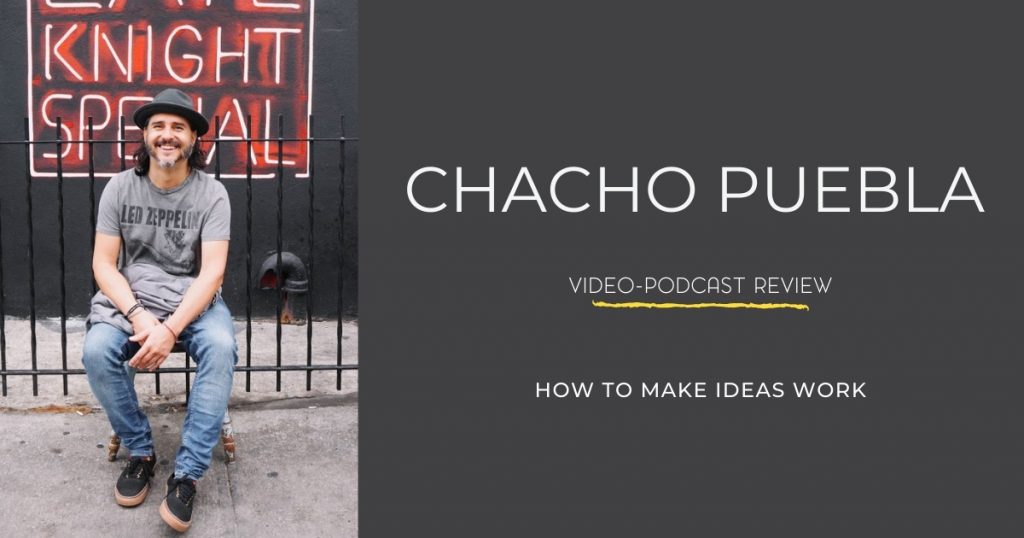We recently spoke with Chacho Puebla, one of the biggest figures in the creative industry. Chacho is ex-CCO and Creative Director at LOLA MullenLowe, and before that was Creative Director at Leo Burnett. We debated the weight of ideas in the creative world and how to put them into action. The way we communicate has changed, and we also discussed what that means for the creative sector.
Puebla began his career in Mendoza, a city known for its influence in the creative and advertising industries. He continued his career in Santiago de Chile, where he learned the differences between small and international markets, as well about all the different opportunities in the advertising industry. He claims this experiences taught him that with a good idea and work ethic, great things can be achieved.
What a great idea. But how will you implement it?
How can you bring your ideas to life? And turn them into something real? It’s not just money you need to execute an idea, sometimes it requires a special touch to get things moving.
There are two things for creatives to keep in mind when a project can’t be undertaken. Firstly, there’s the opportunity to assess whether the idea is really worth it or not. Many projects require more than just funding. Convincing clients to try something new consumes a lot of an agency’s time and energy. And even then, is it a good idea? If not, it’s worth keeping that band’s problem in mind to see if there are any other possible solutions.
Here’s a simple set of questions creatives can follow to help develop ideas:
1) Have you got the resources necessary to carry out the idea? If you don’t, then leave it. It’s that simple, “don’t get obsessed with your ideas”, Chacho reminds us. Although a project may seem hard to undertake, if you have the time, funding and manpower then there’s a chance of success. But the idea is just the first step in the process, next comes effort, research, and knowledge. It’s not enough just to look at what’s working well in the market. Nor should you focus solely on the aesthetic quality of your work.
2) Next, bring the client back to the center of the creative process. It’s their problem you’re solving. Who is the client? Have they been working with the agency for a long time? Is there a relationship and trust? “You get a lot more out of the good things than the bad”. Puebla believes you shouldn’t bother clients for not wanting to take risks in their brand.
How will you sell the idea?
Creatives need to be good salespeople. They need to be persuasive and use the right angles to seduce their client and convince them your idea is the solution, – even if that means stepping out of their comfort zone. Puebla states there will always be bumps in the road, no matter how good an idea is, it’s never faultless and could always be rejected.
“Puebla states there will always be bumps in the road, no matter how good an idea is, it’s never faultless and could always be rejected”
These frustrations are all part of the creative process and need to be tackled at some point. Chacho recalls that a great idea will always be complicated to implement – if it weren’t, everyone would be doing it and every agency would be amazing. Accepting that it’s going to be difficult and that many ideas will be rejected is the first step in this process. “Are you willing to do it or not? You’ll enjoy brainstorming the idea, bringing it to life, and overseeing its inception. Are you willing to do this? If the answer’s no, then it’s not the right agency for you”, asks Chacho rhetorically.
Puebla claims many clients prefer not to take risks when running campaigns. And that’s understandable for certain products and types of clients. Not everyone wants to risk breaking the historic mold and undertaking novel and unconventional ideas. This is frustrating for many creatives leading these accounts. For Chacho, it’s essential to have long-lasting clients while incentivizing your team to keep delivering ideas they’re passionate about. Chacho used to take care of the smaller clients who were happy to take bigger risks, while his colleagues worked on bigger and fresher projects.
The important thing is balance. You’ve got to maintain strong communication with your creative team members, as well as always supporting them and helping them out where necessary. Your team is the heart of your agency, and you need to do all you can to retain your creative talent. You also need to make sure that everyone is working towards the same goals.
Pure creativity or pure ignorance?
“Whatever you don’t know goes against you”, claims Puebla. You need to understand the role of an agency to help you know what to ask for, what to complain about and what to expect. “It’s a business in which, through creativity, we help companies grow and in which we convince people why they should buy from such and such brands”. For Puebla, understanding the political, economic, and financial side of the business is essential to go beyond the role of the creative.
And it’s being familiar with these areas that help us understand the “how and why” behind trends and movements, both within our agency as well as in the border industry. This way our team members truly grasp how to create relevant solutions to various problems and apply their skills to the running of the business. It also allows them to understand why Project Managers take the decisions they do.
The issue of talent and value
For Puebla, there are two main reasons why we retain talent. Firstly, an interest in the projects being undertaken. And secondly, the alignment of a team member’s beliefs and goals with those of the business. It bodes well for your agency if your team members are personally invested in winning prizes, earning more money, and having an impact.
While at LOLA, Puebla saw lots of colleagues leave the business, which he recognizes as a strength. Employees leaving because they feel they can’t grow any further is a good thing. He states he always tried to support his colleagues in their growth and build strong, long-term relationships with his team members. “If we’re going to spend a lot of time working together, then lets make it a long-lasting professional relationship”.
And why is creative work increasingly less valued? For Puebla, it’s because clients are paying less and view agencies as providers and not allies. Many agencies haven’t figured how to reinvent themselves to keep up with the ever-changing communication trends of the past few decades. In their desperation to keep certain accounts, many fall into the trap of doing whatever the clients want, even if the service wasn’t previously offered.
This is one of the issues affecting bigger advertising agencies, and is part of the wider problem of an overworked industry. In cases like this, you need to step back and critically assess how profitable each project is to then decide which services would be most efficient for both the agency and client. Independent agencies with a clear mission and goal tend to fare much better as they have stronger partnerships with their clients and can be more selective around who they work with.
Keeping on the point of internal policies, Puebla claims it’s important for agencies to recognize their ultimate goal is to bring in revenue. And that we mustn’t lose sight of this when there are decisions taken higher up that we don’t understand. Deciding to take on more disruptive and novel projects is a big decision that could end up risking the economic wellbeing of the team.
The decisions taken by an agency’s directors affect everyone in the business. Puebla has first-hand experience of how high turnover in senior roles means a lack of consistent leadership for many agencies. These rapid team changes make it hard to build a long-term vision and plan. Again, it’s new and independent agencies who are managing to buck this trend. These smaller businesses tend to have more experienced leaders and a longer-term vision. And that reflects in how they invest in talent and take decisions.
In the devaluing of advertising work, what comes first: the brand or the agency? There’s been a big shift in the way we communicate, and these new trends have been essential in building relationships with our clients. For Puebla, it’s essential to understand the motives of all parties involved in the process. On the one hand, we need to understand what motivates our people and aim for our creative talent not to get too frustrated, even though that’s part of the process. And on the other, the pressing need to collect and use data, a new trend born out of the digital era.
And if all that wasn’t enough, there’s still the issue of long hours and heavy workloads in the advertising world. For Puebla, the industry is an ecosystem, not a world of uniformity. As such, there’s no one real reason as to why this problem exists. He believes the best thing a creative can do is to be honest with themselves about what they want and what their objectives are. Reflecting on these areas allows one to be true to oneself and put the necessary effort into achieving those goals.
Finally, we’ll leave you with some resources Chacho recommends for creative inspiration:
Books:
1. Hey Wipple Squeeze This / Luke Sullivan
2. Steal like an artist / Austin Kelon
3. The Contagious Commandments: Ten Steps to Bravery / Paul Kemp-Robertson
4. Damn Good Advice / George Lois
5. One Plus One Equals Three: A Masterclass in Creative Thinking / Dave Trott















